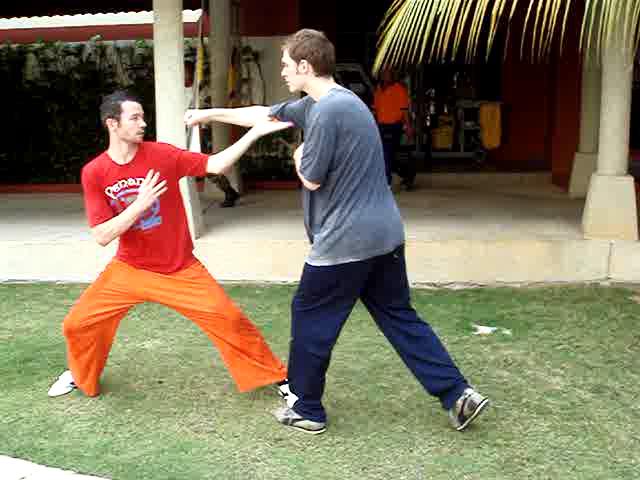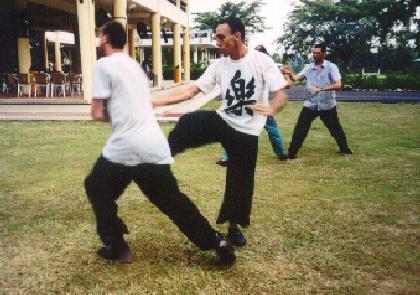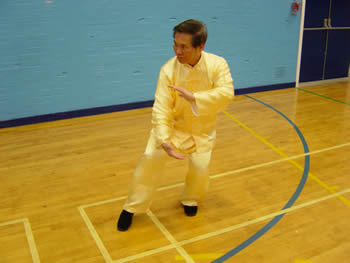May 2003 (Part 3)
SELECTION OF QUESTIONS AND ANSWERS

Sparring using kungfu techniques is an important aspect of kungfu training
Question 1
I recently asked my Sifu whether he had heard of Heng Kung and whether it was possible to do such things. He claimed that he had never heard of Heng Kung and that to do what I had described to him would probably never happen, or if it did, it would take you more than 50 years. Either he really doesn't know, which seems highly unlikely, or he doesn't want to acknowledge its existence and is hiding it for some reason.
— Omar, Australia
Answer
You may have good reasons to think that your sifu knows about the existence of “heng kung” or “the art of lightness” whereby a practitioner can jump high or run fast. But judging from statements made by many whom the general public regard as authorities in their arts, it is no surprise that many instructors or even masters have not heard of “heng kung”, or if they have heard about it they do not believe in it.
Some well known Shaolin masters, including some modern Shaolin monks, whom the public regard as authorities on Shaolin Kungfu, do not believe that classical Shaolin forms can be effectively used for fighting, hence they teach Boxing-like or Kickboxing-like techniques for sparring. Some well known Taijiquan masters, regarded by the public as authorities on Taijiquan, do not believe in chi, hence they use weight-lifting in their force training. If you surf the internet, you can readily find many such examples in the official websites of these masters.
If one practices Shaolin Kungfu but cannot use it for combat, or practices Taijiquan but has no experience of chi, it is bad enough but it is still tolerable, on the assumption that applying kungfu forms for combat, and experiencing chi are rare, advanced skill not readily available to practitioners until much later.
This is not actually true because applying kungfu forms for combat and experience chi, are basic skills, not specialized skills. But when masters themselves publicly state, explicitly or implicitly, that kungfu forms cannot be used in combat or chi is non-existent, the situation becomes alarming. Something has gone seriously wrong in the development or, more correctly, degradation of Shaolin Kungfu and Taijiquan.
To us in Shaolin Wahnam, and we believe to many other kungfu exponents as well, to say that classical Shaolin forms cannot be used for fighting, or chi is non-existent in Taijiquan, is as ridiculous as saying that Albert Einstein did not know physics or a fish cannot swim in water. Yet, in some discussion forums where our Shaolin Wahnam members stated our conviction that Shaolin forms are effective for combat and that chi is an essential aspect of Taijiquan, opposition to these statements was so severe and sometimes bitter that one would think our statements were minority views rather than established facts.
With this understanding, it is no surprise if many sifus do not know of or believe in “heng kung”.
Question 2
I would be very interested in finding a teacher who knows Heng Kung and would be able to teach me one day.
Answer
Today, finding a teacher who is able to teach his students apply kungfu (including Taijiquan) techniques for self defence and use chi to develop internal force, is difficult enough.
Applying kungfu techniques for self defence is a basic skill. In other words, if you practice kungfu, the most basic benefit you get from your training is to use your art for self-defence.
Using chi to develop internal force is a basic skill in Taijiquan, though it is not so in many other styles of kungfu. But all styles of kungfu have some knowledge of chi, even though these styles may not apply chi to develop internal force, because chi is a fundamental concept in Chinese culture. If you are tired, for example, the Chinese expression is that you do not have enough chi.
On the other hand, “heng kung” is not a basic skill or a common skill in any style of kungfu. It is a very specialized skill taught to specially selected disciples. I would not want to teach you "heng kung" over an e-mail.
Question 3
Have you had any experience with Heng Kung ?
Answer
Yes, reportedly as well as directly. My sifu, Sifu Ho Fatt Nam, described to me his own experiences in learning “heng kung”. He also told me that his sifu could jump up a wall of about 10 feet.
Many years ago, I practiced “heng kung”. After a few months I reached a stage where I could jump on the spot to a height of about 5 feet. But, regrettably, I discontinued the training.

Taijiquan is not a dance, but a very effective internal kungfu style. Hence, combat application is an essential aspect of Taijiquan training. Here Sifu Jeffrey Segar, Wahnam Taijiquan instructor of Shaolin Wahnam Switzerland, and Sifu Roberto Lamberti, Wahnam Taijiquan instructor of Shaolin Wahnam Costa Rica and Colombia use typical Taijiquan patterns in their free sparring during a Special Taijiquan Course in Malaysia.
Question 4
I have gained increasing interest in Hsing Yi Kungfu, besides the Hung Gar Kungfu that I practice. It appears to be a style that may match my physique and characteristics. I am rather big-boned and heavy. I have purchased an English version of Sun Lu Tang's “Hsing-I Boxing” and have read from many sources, including your Q&A webpage, confirming that this internal style is extremely effective in combat while retaining all the health benefits worthy of an internal martial art. I am currently searching for an instructor who is proficient in this formidable internal martial art. Can you please kindly advise?
— Mark, Malaysia
Answer
Hsing Yi Kungfu is an excellent martial art. It is one of the three most famous styles of internal kungfu. Although these three internal styles — Hsing Yi, Bagua and Taijiquan — are often collectively regarded as Wudang Kungfu, mainly due to Sun Lu Tang's involvement in all the three arts, Hsing Yi Kungfu actually developed from Shaolin.
The founder of Hsing Yi Kungfu was Yue Fei, a Shaolin disciple and army marshal of the Song Dynasty. Yue Fei, who like Guan Yu of the Three Kingdom Period is now worshipped as the Chinese God of War, also founded Eagle Claw Kungfu and Yue Family Kungfu.It is not easy to find Hsing Yi masters nowadays. But if you find one, it is more likely than not that he teaches genuine kungfu, whereas in other kungfu styles, including Hung Gar, it is more often than not that he teaches external kungfu forms. This is so because as there are comparatively less forms in Hsing Yi Kungfu, the instructor usually has to focus on force training and combat application, whereas in other styles where there are many forms, the instructor often teaches one kungfu set after another.
You will probably find that the typical training methods in Hsing Yi are quite different from what you are used to in Hung Gar. In Hung Gar, students typically focus on performing kungfu sets, paying attention to accurate forms and forceful movements, and on punching sandbags and sometimes lifting weights. In Hsing Yi, students focus on repeating and repeating a few movements and on stance training.
Question 5
I note from many books on Hsing Yi that the movements are nowhere close to Shaolin in terms of complexity and variety of movements. I find it hard to imagine how it can possibly qualify as a versatile martial art form. How is it possible?
Answer
Both the hard forms and footwork of Hsing Yi Kungfu are nowhere like those of Shaolin. This is no surprise because Shaolin Kungfu is so rich in its philosophy and repertoire that other martial arts can hardly come close.
Yet, Hsing Yi Kungfu is versatile, and a very good one too. It is, in my opinion, superior to many other martial arts. For example, if you lock the arm of a Karate exponent, kick at a Western Boxer, or pin a Taekwondo exponent to the ground, they may not know what to do. This is because as such modes of attacks are not permissible in these arts, their exponents are not trained to defend against these attacks. Strictly speaking they are martial sports rather than martial arts; they are practiced for recreation rather than for real fighting, and hence safety rules are both necessary and sensible.
But Hsing Yi Kungfu is a martial art, and is complete by itself, which means it is not necessary to borrow anything from other arts. Many other martial arts are not complete by themselves. Therefore their exponents need to cross-train, i.e. learn certain special techniques or skills from other arts, to supplement their inadequacy.
Hsing Yi Kungfu is practiced for real fighting, hence there are no safety rules. An exponent of Hsing Yi Kungfu, despite its relatively narrow range of techniques when compared to Shaolin Kungfu, can counter any modes of attack. More significantly, Hsing Yi Kungfu emphasizes internal force training, which means, besides other benefits, it contributes to health and vitality besides combat efficiency.
Hsing Yi Kungfu is a versatile martial art although it does not have a wide range of techniques like Shaolin Kungfu. This is possible because of its focus on internal force, good stances and skilful application of simple techniques.
Take the following pattern called “Green Dragon Emerges from Water” as an example. First punch out your right vertical fist in a left Bow-Arrow Stance. Bring your front left leg backward into a Stolen Step (which is the reverse of a Unicorn Step) and simultaneously pull back your right fist as you punch out your left vertical fist, moving the left fist forward under your right arm.
Many people may not know what this pattern is for? Some may wonder why you retreat into a Stolen Step, and not into some other stances or simply bounce away. The fact is that a skilful Hsing Yi exponent can apply this simple pattern to counter almost any attacks, including an opponent gripping his right arm or left leg, kicking him in various ways, or throwing him over! It would be too verbose to describe here these counters against various attacks using only this pattern, but it suffices to say without good stances and internal force, the counters would not be effective even if the technique is performed correctly.
Question 6
Please could you tell me in performing “Lifting the Sky”, fig 3.1(b) from your book “Chi Kung for Health and Vitality”, while pushing my hands up should my knees remain slightly bent or should they straighten?
— Peter, England
Answer
Your knees should be straightened, but they should not be locked.
Nevertheless, you need not be over-concerned about your knees. So long as you keep your legs reasonably straight — even if your knees may be slightly bent — you will be all right. It is more important to be relaxed and to enjoy your exercise.

Chi, or energy, is an essential aspect in Taijiquan training. Here Sifu Wong uses “Grasping Sparrow's Tail” to generate an internal chi flow..
Question 7
One of my forms is called “Big Buddha Palm”. It is soft, slow, circular and full of palms, slaps, chops, hidden chin-na and pokes. It has slaps to the kidney, face, groin, backhand slaps, wavelike slapping blocks etc.
This set does not match any “Dai Fut Jeung” (“Big Buddha Palm”) from Choy-Li-Fatt systems I have seen. I heard from my Sisok my Sigung had said it was a form handed down from Bak Mei. I had contacted Bak Mei stylists and they did not hear of a form like it, and our movements do not look much like the straight Bak Mei moves we see nowadays.
Have you ever heard of any Bak Mei styles that are soft like Tai Chi and are using only palms and chin-na? Is it possible that my Sisok mis-heard the name Bak Mei for Bak Mor (Jiu) of Hung Fatt? And Hung Fatt has a Buddha Palm set in their system. Did Bak Mei have any relationship to Fatt Gar? Did he practice or teach it at all?
— David, USA
Answer
Your “Big Buddha Palm” is not likely from Choy-Li-Fatt or from Hung-Fatt because both these styles are comparatively hard and external, whereas your set is soft and internal. The set was also unlikely from Bak Mor Jiu, a Hung Fatt master, as he was not known to be soft and internal.
I believe your Sisok (teacher's junior classmate) and Sigung (teacher's teacher) were right. Your “Big Buddha Palm” was most likely from Bak Mei.
Bak Mei, the Taoist priest who was the siheng (senior classmate) of Chee Seen, the grandmaster of Southern Shaolin Kungfu, was a kungfu genius. Bak Mei practiced many different types of kungfu, and was a grandmaster of the soft and internal arts. Even at an advanced age, his complexion was like that of a child, and he was extremely powerful. The “Big Buddha Palm” you described would fit very well with his kungfu styles as well as with his personality.
A probably reason why those Bak Mei stylists you consulted, had not heard of this soft, internal kungfu set was because it was not passed down in their system. This may not be surprising because this set, if practiced properly, is an advanced set.
Bak Mei did not have direct relationship with Hung Fatt Kungfu or with Fatt Gar Kungfu. These two kungfu styles are more related to the lineage of Chee Seen. And Chee Seen and Bak Mei were sworn enemies. Chee Seen was killed by Bak Mei when the latter led the Qing army to raze the Southern Shaolin Monastery at Jiu Lian Shan built by Chee Seen. Hence, I think your “Big Buddha Palm” could have been introduced to your style by a master outside your lineage proper.
Nevertheless, since Bak Mei and Chee Seen were kungfu classmates, and Hung Fatt and Fatt Gar were issued from Chee Seen. Bak Mei had indirect relationship with these two kungfu styles.
As mentioned earler, Bak Mei was a kungfu genius. He not only practiced but taught many styles of kungfu. He was the First Patriach of Bak Mei Kungfu, Dragon Style Kungfu and Ermei Kungfu.
Question 8
There are rumours that the current Bak Mei styles are really offshoots of Dragon Style and may not be purely coming from Bak Mei. Rumors are hard to see through, so only add confusion when people like me do historical research. Now I am motivated to learn Chinese so that I can read more books written in Chinese.
Answer
Both Bak Mei Kungfu and Dragon Style Kungfu came from Bak Mei.
Ng Mui, Bak Mei, Chee Seen, Foong Tuo Tuck and Miu Hein learned from Cheong Mei at the Southern Shaolin Monastery at Quanzhou. This monastery was razed to the ground by the Qing army directed by the emperor himself, Yong Cheng, assisted by Lama kungfu experts from Tibet.
Ng Mui escaped to Yunnan, Bak Mei to Ermei Mountain in Sichuan, Chee Seen to Jiu Lian Shan in Fujian, Foong Tuo Tuck to Wudang Mountain in Hubei, and Miu Hein to Guangdong. These five grandmasters were known as the “Shaolin Five Elders”.
Ng Mui was a nun, so she did not stay at the Shaolin Monastery but went there to learn kungfu from Cheong Mei. She stayed in a nunnery nearby. It is not known for sure whether she was at the monastery when it was razed.
Another grandmaster who escaped the razing of this Southern Shaolin Monastery was Jiang Nan. He was comparatively not known in Chinese kungfu literature because he ran out of China. About 50 years later at the Thai-Malaysian border he taught the Shaolin arts to Yang Fatt Khun, who later taught Ho Fatt Nam, my Shaolin master.
The lineage of my other Shaolin master, Uncle Righteousness, is traced back to Chee Seen.
The kungfu taught by Bak Mei at Ermei Mountain was known as Ermei Shaolin Kungfu, and later shortened to Ermei Kungfu. Later two styles issued from Ermei Kungfu, namely Bak Mei Kungfu and Dragon Style Kungfu.
